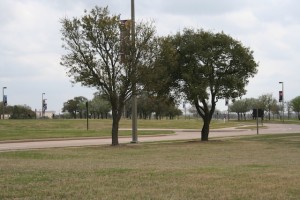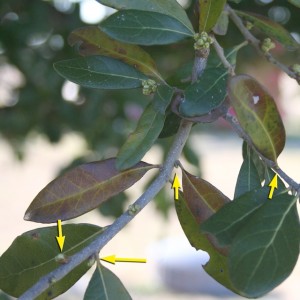 As spring comes to many parts of Texas, so does an interesting phenomenon. In March through early May of every year, we get calls for help with “dying” oak trees. The yellowing and scorched leaves often result in defoliation (dropping of leaves). Many believe that this is a result of some disease. Unfortunately (or fortunately, depending on how you see it) this is a natural occurrence in Texas live oaks. These trees stay green through the winter and will begin to shed their leaves when the weather starts to get warm. The shedding of leaves are in preparation for new leaves. Usually new leaves will appear shortly after leaves are shed. New leaves may also be appearing while old leaves are dropping. Sometimes, this explanation is not sufficient to our client who responds with,”But my other live oak still looks okay.”
As spring comes to many parts of Texas, so does an interesting phenomenon. In March through early May of every year, we get calls for help with “dying” oak trees. The yellowing and scorched leaves often result in defoliation (dropping of leaves). Many believe that this is a result of some disease. Unfortunately (or fortunately, depending on how you see it) this is a natural occurrence in Texas live oaks. These trees stay green through the winter and will begin to shed their leaves when the weather starts to get warm. The shedding of leaves are in preparation for new leaves. Usually new leaves will appear shortly after leaves are shed. New leaves may also be appearing while old leaves are dropping. Sometimes, this explanation is not sufficient to our client who responds with,”But my other live oak still looks okay.”
So why the difference? The best explanation that I can give is that each tree can be looked upon as an individual, with specific characteristics. Those trees may be different genetically, making one shed and produce new leaves quicker than another. It is also possible that there are environmental and/or physical factors that influences a particular plant to shed quicker.
Nevertheless, this leaf drop phenomenon is one that we live with in Texas. It is NOT cause by a disease. It is part of the natural life cycle of the tree. However, if you are still concerned, the following are a few things you could do:
1. Bend the small branches or twigs.
If they are pliable, the tree is alive (NORMAL). If it is brittle (and snaps easily), chances are that the branch is dead (PROBLEM).
2. Look for leaf buds or newly developing leaves.
New swelling leaf buds should be clearly visible when trees are dropping leaves. Occasionally, you may see new tiny leaflets starting to form as leaves drop off.
For a one-page handout on this “issue”, check out the Live oak spring leaf drop factsheet.





